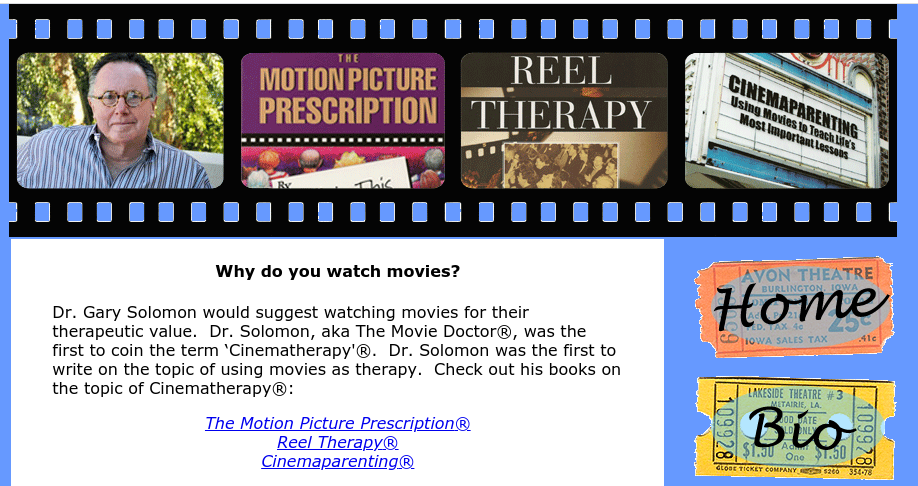
“Cinema therapy or movie therapy is a form of expressive therapy – like art, music and dance therapy – for medical and mental health issues. It is also used as a form of self-help. Cinema therapy was created and popularized by Dr. Gary Solomon, the first to write on using movies as therapy. The movement started to catch up again in 2019 with the featured documentary “Calypsonians” by director Anghelo Taylor, unlike the creation of Dr. Gary Solomon, Anghelo Taylor wrote the CinemaTherapy Manifesto, that starts with one simple principle “In order for cinema therapy truly exist the filmmaker must have an internal search, question or problem to solve inside himself but that relates with the rest of humanity or with specific community. Once the filmmaker and his crew engage in the process of filmmaking, they start healing by the revelation and situations that happen along the process of making a film. In the end, the result of that process will be a medicine for all the viewers as human beings. But everything starts with the deep intention that the filmmaker has when making the film”
Dr. Cohen hosted a seminar at Colorado College in 1997 to discuss the viability of using movies as a source of healing. A bachelor's thesis was subsequently written on this topic, which is copyrighted and registered with the copyright office. During the seminar, Dr. Gary Solomon, a psychotherapist from Portland, Oregon, who had published extensively on this subject, was flown out to Colorado Springs to deliver a lecture. Other participants on the panel included Peggy Berg from Colorado College's dance department, who was studying dance movement therapy at Naropa; Barry Sarchett from the English department at Colorado College, who taught film studies; Tom Sanny, who was in charge of filmmaking classes at Colorado College; and Greg Alba from Victory Outreach ministries, who shared his personal journey of leaving a gang-related life through participation in theatrical plays organized by the church.
Film/video-based therapy[edit]
Joshua Lee Cohen, author and co-editor of Video and Filmmaking as Psychotherapy: Research and Practice (published by Routledge in 2015), helped to establish a collaborative effort in forming Film/video-based therapy. This form of therapy is about making films with clients, as opposed to cinema therapy which is about watching films. Dr. Cohen also hosted a seminar for Dr. Solomon at Colorado College in 1997. Dr. Cohen was inspired by Dr.Solomon’s work to build on the concept of cinematherapy. Dr. Cohen began searching for ways to make films for therapeutic purposes and eventually sought out others who used film/video as a part of psychotherapy. He then wrote his dissertation on the subject and eventually published an academic book mentioned above.
Dr. Cohen raised the grants and planned this seminar in 1997 for Dr. Gary Solomon https://www.cinema-therapy.com/ It was a public event at Colorado College, funded, in part by the CCC student government and a Venture Grant through the School. The event was video taped over six hours and covered Cinematherapy. The Leftover food from the catering, the Marriott, went to the local soup kitchen.
The panel discussion involved Greg Alba from Victory Outreach Ministries, Tom Sanny, a film professor, Barry Sarchett, an English/Film professor, and Peggy Berg, a somatic dance student from Naropa.
This is a Student Film based on Dr. Cohen’s Bachelor’s Thesis, this seminar, and several interviews with people from Hollywood, Academics, and Market Research. For more on the origins of Film/Video-Based Therapy at Colorado College. Please contact Dr. Cohen to see the entire film.
References:
Cohen, J. (2000). Catharsis: Film-healing: Collaborative art-therapy. Retrieved June 25, 2015, from https://cocollege.bywatersolutions.com/cgi-bin/koha/opac-detail.pl?biblionumber=22806 Copyright
Cohen, J. (1998). Catharsis: A video seminar [Video]. Retrieved from
https://cocollege.bywatersolutions.com/cgi-bin/koha/opac-detail.pl?biblionumber=17758&query_desc=kw%2Cwrdl%3A%20catharsis%20video